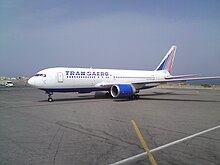Heraklion Airport
| Airport Nikos Kazantzakis Airport Nikos Kazantzakis Αερολιμένας Νίκος Καζαντζάκης |
|
|---|---|

|
|
| Characteristics | |
| ICAO code | LGIR |
| IATA code | HER |
| Coordinates | |
| Height above MSL | 35 m (115 ft ) |
| Transport links | |
| Distance from the city center | 3 km east of Heraklion |
| Basic data | |
| opening | 1937, first landing in 1939 |
| Terminals | 1 |
| Passengers | 7,843,587 (2019) |
| Air freight | 792 t (2019) |
| Flight movements |
53,000 (2019) |
| Runways | |
| 09/27 | 2714 m × 45 m asphalt |
| 12/30 | 1566 m × 50 m asphalt |
| 18/36 (closed) |
780 m × 40 m asphalt |
The Heraklion "Nikos Kazantzakis" airport ( IATA code : HER , ICAO code : LGIR ; and Heraklion International Airport "Nikos Kazantzakis" ; Greek Κρατικός Αερολιμένας Ηρακλείου "Νίκος Καζαντζάκης" Kratikos Aerolimenas "Nikos Kazantzakis" ) is the main airport of the Greek island Crete and was completed in 1937. In terms of passenger volume, it is the second largest airport in Greece after Athens Airport. It is named after the writer and philosopher Nikos Kazantzakis , who was born in Heraklion in 1883. The airport is to be replaced by a new one in a few years .
The airport is located about three kilometers east of the center of Heraklion in the area of the municipality of Nea Alikarnassos not far from the port.
history
The airport opened in March 1939. The state airline HEES flew daily from Athens on Ju-52 aircraft .
During the time of the Second World War , the civil use ceased. Fighter planes of Lehrgeschwaders 1 and Kampfgeschwaders 77 of the German Air Force used the base to carry out attacks on ships, North African ports and the Suez Canal in the eastern Mediterranean.
With the opening of the 1850 meter long runway 09/27, larger aircraft could land in Heraklion for the first time, and Olympic Airways started direct flights in 1954. In order to cope with the increasing number of passengers, a new terminal was opened in 1971. The building has been continuously expanded to this day, and despite extensive measures to expand the airport since the late 1980s , the terminal is still barely able to cope with the high passenger flows in the summer months. In addition, additional parking positions were set up and the existing runway renewed. 15 parking positions enable larger aircraft up to Boeing 747 to be handled . From 1987 to 1998, Heraklion almost doubled its passenger numbers from 2,399,888 to 4,188,473. In 2014 more than 6 million guests were handled, in 2019 already 8 million.
For most aircraft taking off, it was still necessary until at least 2007 to taxi a little across the runway to the take-off position. This severely reduced the capacity for possible flight movements. With the completion of taxiway D, this problem was resolved.
particularities
As a rule, the approach to landing on runway 27 is in a westerly direction. The airport has three runways, two of which are still in operation. Due to the location of the airport, cross winds from north or north-westerly directions often occur when approaching runway 27 . To reduce noise , a right turn is flown in the same direction after take-off to bypass the city center of Heraklion.
The airport only has external positions without passenger boarding bridges and, despite the high number of flight movements, Heraklion Airport does not yet have an instrument landing system .
Destinations
A large number of European charter, scheduled and low-cost airlines fly to the airport, especially in the summer season.
As the largest Greek airlines, Aegean Airlines and Olympic Air also offer connections to Heraklion in the winter flight schedule. In the summer season there are regular connections to Athens , Thessaloniki and Rhodes .
Russian airlines such as Aeroflot and UTAir have also increasingly come to Heraklion in recent years .
Accidents and incidents
To date, there are no known accidents in which people were injured or killed at Heraklion Airport. Only minor incidents without personal injury are known.
On June 25, 2011, a Boeing 737-800 of the Hungarian airline Malév made contact with the ground ( tail strike ) in the area of the tail after touching down and suffered damage.
Web links
- Airport Heraklion (German)
- Airport data on World Aero Data ( 2006 )
- Information heraklion-airport.info (English)
- Information heraklionairport.net (English)
Individual evidence
- ↑ a b c AIR TRAFFIC STATISTICS 2019. In: ypa.gr. Hellenic Civil Aviation Authority, accessed June 8, 2020 .
- ↑ Airport data on World Aero Data ( English, as of 2006 )
- ↑ Accident: Malev B738 at Heraklion on June 25th 2011, tail strike on landing. The Aviation Herald , June 26, 2011 (English); Retrieved April 14, 2014.


